We talked about scope creep in a previous installment of this series. I mention it again because scope creep happens when you, the client, want newly defined value from the work being delivered without adding to the value you’re providing to your vendor. This is a nice segue into a conversation about value-based pricing.
Let’s delve deeper into the concept of value-based pricing, a strategy that can empower you in your negotiations and ensure you get the most out of your budget!
As a Marketing Director or Marketing VP, you play a crucial role in the negotiation process. Your input and understanding of the budget are key.
Let’s start from the beginning and pick it up from there.
The conventional wisdom is that whoever blinks first, as in, puts out the first number–loses. Is this actually true? Because we think about it a little differently. Very often, in fact, most often, the Marketing Director or Marketing VP, you, will say to us that they don’t know what their budget is, that they need us to tell them what the work will cost.
Often this is true – and it’s fair. We’re happy to do it. However, there are plenty of times when our prospect, you, actually has a budget in mind, or a number they’ve been given by another stakeholder, or an amount they’re able to spend on the work.
When we’re negotiating, we’ll ask for a “do not exceed” number. What’s an amount you already know you can’t go above? What is a budget number that kills this project (because it’s more than you can spend), or ends our ability to work with you on it (because it would cost us money to deliver the work you need)?
Here’s why I think it’s to your advantage to say what that number is. The way we work, if we aren’t competing on price, which we’ve said we don’t do anymore, it means we’re competing on value.
Let me explain.
Instead of trying to figure out how cheaply a project can be completed, why not instead figure out how well it can be done, given the money you have for it? We’ve been in business for 20 years, and that means we know how to cram as much value as we possibly can into your project, given the budget you have available.
In value-based pricing, the focus shifts from simply delivering a project for the lowest possible cost to maximizing the value of the work based on your budget. This approach ensures that the price you pay reflects the quality and benefits of the deliverables rather than just the time or materials involved. By sharing your budget constraints openly with your vendor, you hand them the ability to craft a proposal that leverages their expertise to maximize the value of every dollar spent. This collaboration leads to better outcomes, enhanced satisfaction, and stronger long-term partnerships as we (the vendor) become more invested in meeting your goals.
As a buyer of creative services, you should be seeking out vendors who understand the value of their work, understand the purpose of the project you need, and can make it as well as it can be made, given the money you have to spend. SURE, if you name the budget, we’ll spend all of it, but we’ll also earn every dollar – leaving you with the best possible result for your money.
Call this chapter 2 of “Why race to the bottom.” Let’s practice a little more transparency, and let’s lean into value-based pricing together.

